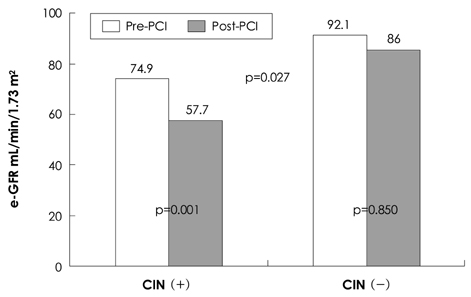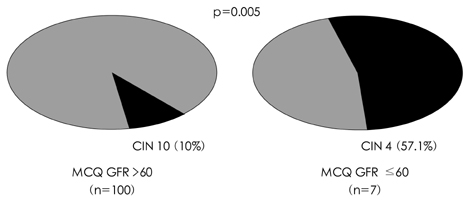Korean Circ J.
2008 Jun;38(6):301-304. 10.4070/kcj.2008.38.6.301.
The Estimated Glomerular Filtration Rate With Using the Mayo Clinic Quadratic Equation as a New Predictor for Developing Contrast Induced Nephropathy in Patients With Angina Pectoris
- Affiliations
-
- 1Cardiology Division, Department of Internal Medicine, Yeungnam University Medical Center, Daegu, Korea. yjkim@med.yu.ac.kr
- KMID: 2225776
- DOI: http://doi.org/10.4070/kcj.2008.38.6.301
Abstract
-
BACKGROUND AND OBJECTIVES: The Mayo clinic quadratic (MCQ) glomerular filtration rate (GFR) equation accurately estimates the GFR when the presence of kidney disease is unknown. The aim of this study is to evaluate the usefulness of the MCQ GFR equation for predicting contrast-induced nephropathy (CIN) in patients with angina pectoris and who are undergoing coronary angiography (CAG) or percutaneous coronary intervention (PCI).
SUBJECTS AND METHODS
One hundred seven patients diagnosed with stable or unstable angina and who had normal serum creatinine levels (SCr <1.5 mg/dL) were enrolled. The MCQ GFRs, corresponding to before and 48 hours post CAG and/or PCI were calculated using the SCr as a previously described protocol. CIN was defined as a 25% elevation in the SCr or an absolute increase of 0.5 mg/dL (44 micromole /L).
RESULTS
Overall, CIN occurred in 14 (13.1%) patients. CIN developed in 4 (57.1%) patients who had an estimated MCQ GFR less than 60 mL/min/1.73 m2 and in 10 (10%) patients who had a GFR over 60 mL/min/1.73 m2 (p=0.005). On univariate analysis, CIN was associated with the baseline MCQ GFR (p=0.001), the C-reactive protein (CRP) level (p=0.001), the volume of contrast agent (p=0.005), the left ventricular ejection fraction (p=0.001) and the low density lipoprotein cholesterol level (p=0.030). On multivariate analysis, a baseline MCQ GFR < or =60 mL/min/1.73 m2 [odds ratio (OR)=2.0, p=0.001], the volume of contrast agent > or =250 mL (OR 17.1, p=0.002), a CRP level > or =0.5 mg/dL (OR 4.7, p=0.037) and a left ventricular ejection fraction < or =40% (OR 1.7, p=0.020) were the independent risk factors for CIN.
CONCLUSION
The pre-coronary angiography MCQ GFR is a useful predictor for the development of CIN. Strong preventive strategies are needed to avoid developing CIN in these high-risk patients.
MeSH Terms
-
Angina Pectoris
Angina, Unstable
Angiography
C-Reactive Protein
Cholesterol
Cholesterol, LDL
Contrast Media
Coronary Angiography
Creatinine
Glomerular Filtration Rate
Humans
Kidney Diseases
Lipoproteins
Multivariate Analysis
Percutaneous Coronary Intervention
Risk Factors
Stroke Volume
C-Reactive Protein
Cholesterol
Cholesterol, LDL
Contrast Media
Creatinine
Lipoproteins
Figure
Reference
-
1. Best PJ, Lennon R, Ting HH, et al. The impact of renal insufficiency on clinical outcomes in patients undergoing percutaneous coronary interventions. J Am Coll Cardiol. 2002. 39:1113–1119.2. Rihal CS, Textor SC, Grill DE, et al. Incidence and prognostic importance of acute renal failure after percutaneous coronary intervention. Circulation. 2002. 105:2259–2264.3. Rich MW, Crecelius CA. Incidence, risk factors, and clinical course of acute renal insufficiency after cardiac catheterization in patients 70 years of age or older: a prospective study. Arch Intern Med. 1990. 150:1237–1242.4. Rigalleau V, Lasseur C, Raffaitin C, et al. The Mayo Clinic quadratic equation improves the prediction of glomerular filtration rate in diabetic subjects. Nephrol Dial Transplant. 2007. 22:813–818.5. Murphy SW, Barrett BJ, Parfrey PS. Contrast nephropathy. J Am Soc Nephrol. 2000. 11:177–182.6. Fishbane S, Durham JH, Marzo K, Rudnick M. N-acetylcysteine in the prevention of radiocontrast-induced nephropathy. J Am Soc Nephrol. 2004. 15:251–260.7. Gleeson TG, Bulugahapitiya S. Contrast-induced nephropathy. AJR Am J Roentgenol. 2004. 183:1673–1689.8. Maeder M, Klein M, Fehr T, Rickli H. Contrast nephropathy: review focusing on prevention. J Am Coll Cardiol. 2004. 44:1763–1771.9. Goldenberg I, Matetzky S. Nephropathy induced by contrast media: pathogenesis, risk factors and preventive strategies. CMAJ. 2005. 172:1461–1471.10. Rule AD, Larson TS, Bergstralh EJ, Slezak JM, Jacobsen SJ, Cosio FG. Using serum creatinine to estimate glomerular filtration rate: accuracy in good health and in chronic kidney disease. Ann Intern Med. 2004. 141:929–937.11. Pannu N, Wiebe N, Tonelli M. Prophylaxis strategies for contrast-induced nephropathy. JAMA. 2006. 295:2765–2779.12. Barrett BJ, Parfrey PS. Clinical practice: preventing nephropathy induced by contrast medium. N Engl J Med. 2006. 354:379–386.13. Jeon SH, Seol GH, Suh SH, Park SH. Nitric oxide-induced intracellular Ca2+ modulation in macrovascular endothelial cells. Korean Circ J. 2004. 34:600–609.14. Bakris GL, Lass N, Gaber AO, Jones JD, Burnett JC Jr. Radiocontrast medium-induced declines in renal function: a role for oxygen free radicals. Am J Physiol. 1990. 258:F115–F120.15. Levey AS, Coresh J, Balk E, et al. National Kidney Foundation practice guidelines for chronic kidney disease: evaluation, classification, and stratification. Ann Intern Med. 2003. 139:137–147.16. Cockcroft DW, Gault MH. Prediction of creatinine clearance from serum creatinine. Nephron. 1976. 16:31–41.17. Levey AS, Bosch JP, Lewis JB, Greene T, Rogers N, Roth D. A more accurate method to estimate glomerular filtration rate from serum creatinine: a new prediction equation. Ann Intern Med. 1999. 130:461–470.18. Namgung J, Doh JH, Lee SY, Huh WS, Park SW, Lee WR. Effect of N-acetylcysteine in prevention of contrast-induced nephropathy after coronary angiography. Korean Circ J. 2005. 35:696–701.
- Full Text Links
- Actions
-
Cited
- CITED
-
- Close
- Share
- Similar articles
-
- Nephropathy related to computed tomography in emergency department patients with serum creatinine <1.5 mg/dL
- Determination of Safe Contrast Media Dosage to Estimated Glomerular Filtration Rate Ratios to Avoid Contrast-Induced Nephropathy After Elective Percutaneous Coronary Intervention
- Estimated Glomerular Filtration Rates Show Minor but Significant Differences Between the Single and Subgroup Creatinine-Based Chronic Kidney Disease Epidemiology Collaboration Equations
- Increased Carotid Intima-Media Thickness is Associated with Progression of Diabetic Nephropathy in Patients with Type 2 Diabetes
- Diabetic Nephropathy and Glomerular Filtration Rate



